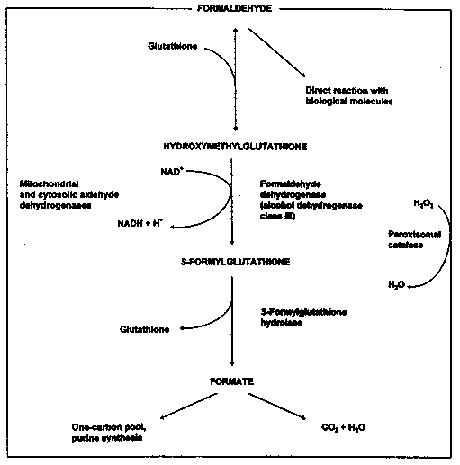|
|
Toxicological evaluation and limit values for Methyl-tertiary-butyl ether (MTBE), Formaldehyde, Glutaraldehyde, Furfural
2. Toxicokinetics
2.1 Absorption, distribution
The endogenous concentration of formaldehyde in the blood of human subjects not exposed to formaldehyde is reported to 2.6 mg/kg as the sum of free and reversible bound formaldehyde (IARC 1995).
Inhalation
In experimental animals almost 100% of inhaled formaldehyde is retained by the tissues of the respiratory tract. The retention takes place almost entirely in the nasal passages of rats. In rhesus monkeys retention occurs primarily in the nasal passages but also in the trachea and proximal regions of the major bronchi. The efficiency by which formaldehyde is retained was found to be determined by the nasal anatomy, as structures causing more narrow and complex air flow enhances retention by the surface of the nasal mucosa (IARC 1995).
At identical exposure levels mice were found to receive a lower effective dose at the target tissue in the nasal cavities than rats as the mice reacted with a greater reduction in minute ventilation as a response from sensory irritation of the respiratory tract. The less intense exposure of mice were further verified by smaller increases in cell proliferation in the nasal mucosa compared to rats. The authors suggested that these findings could explain why higher formaldehyde exposure levels were needed to induce the same degree of toxic effects (e.g. nasal tumours) in mice as seen in rats at lower levels (Chang et al. 1983).
In rats and humans increases in blood concentration of formaldehyde were not detected after formaldehyde exposure because of high reactivity and rapid metabolism (IPCS 1989). Thus, no changes in blood formaldehyde content were found in rats exposed for 2 hours to 17.6 mg/m3 or in monkeys exposed for 6 hours/day, 5days/week during four weeks to 7.3 mg/m3 (IPCS 1995).
Oral intake
In experimental animals formaldehyde is rapidly and almost completely absorbed after oral exposure. A substantial part of radioactivity from radiolabelled formaldehyde was found distributed in the carcass because of metabolic incorporation of the radiolabelled carbon (IARC 1995).
There is no data showing that formaldehyde per os give rise to increased formaldehyde levels in blood, so formaldehyde is most probably instantaneously converted by reaction with macromolecules or by metabolic processes.
Dermal contact
In monkeys less than 1% of a dose of an aqueous formaldehyde solution applied to skin was absorbed (amount of radioactivity gained from expired air), while 10% was bound to the exposed skin area. In rats about 30% absorption of formaldehyde from skin application has been registered. (IARC 1995).
There is no data showing that formaldehyde after dermal exposure gives rise to increased formaldehyde levels in blood, so formaldehyde is most probably instantaneously converted by reaction with macromolecules at the skin surface or by metabolic processes during penetration of the skin layer.
2.2 Elimination
Metabolism
As human erythrocytes contain formaldehyde dehydrogenase and aldehyde dehydrogenase absorbed formaldehyde may be rapidly metabolised (IARC 1995). The metabolism of formaldehyde is illustrated in Figure 2.1.
Figure 2.1 Metabolism and fate of formaldehyde (from IARC 1995).
Formaldehyde can react with macromolecules at the site of entry. DNA-protein cross-links have been detected in tissues exposed directly to formaldehyde, but not in tissues remote from the absorption site. Formaldehyde subjected to metabolism are incorporated into macromolecules via one-carbon path-ways or are eliminated in the expired air (CO2) and urine. (IPCS 1989).
Excretion
In rats about 40% of the inhaled dose of radiolabelled formaldehyde (0.8 and 16 mg/m3 for 6 hours) was eliminated as CO2 over a 70-hour period; 17% of the radioactivity was excreted in the urine; 5% was eliminated in faeces while 35-39% remained in tissues and carcass (IARC 1995).
Using radiolabelled formaldehyde 40% of an oral dose in rats was found to be eliminated with the expiratory air as CO2. Ten percent was eliminated with urine and 1% with faeces (IARC 1995).
Seventy-two hours after dermal exposure to rats, 6.6% of the applied dose of formaldehyde was eliminated with the urine, while less than 1% was recovered from expiratory air (IARC 1995).
|
[Front page] [Contents] [Previous] [Next] [Top] |
